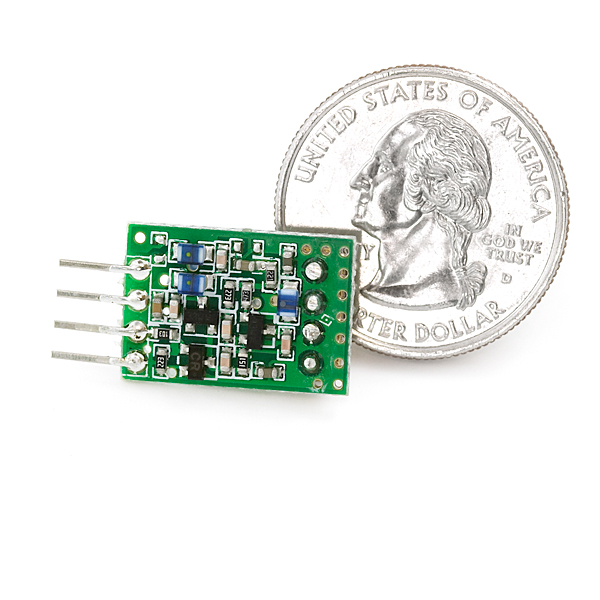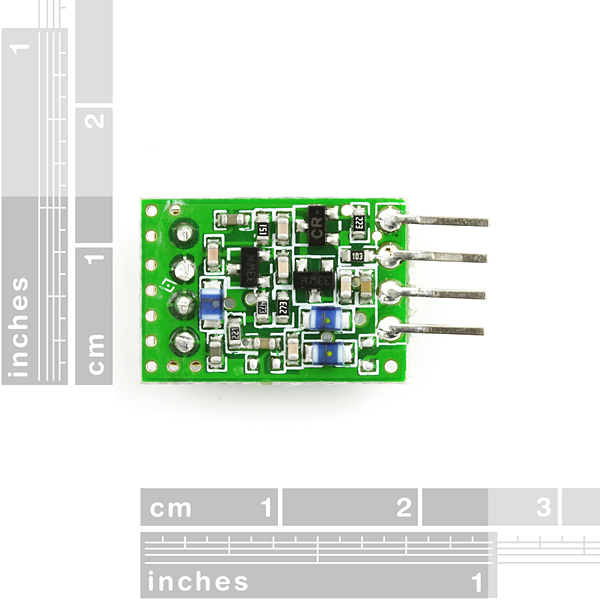RF Link Transmitter - 434MHz
Replacement: None. We are looking for a new supplier for these, but don't have a replacement yet. This page is for reference only.
This is only the 434MHz transmitter. This will work with the RF Links at 434MHz at either baud rate. Only one 434MHz transmitter will work within the same location.
This wireless data is the easiest to use, lowest cost RF link we have ever seen! Use these components to transmit position data, temperature data, even current program register values wirelessly to the receiver. These modules have up to 500 ft range in open space. The transmitter operates from 2-12V. The higher the Voltage, the greater the range - see range test data in the documents section.
We have used these modules extensively and have been very impressed with their ease of use and direct interface to an MCU. The theory of operation is very simple. What the transmitter 'sees' on its data pin is what the receiver outputs on its data pin. If you can configure the UART module on a PIC, you have an instant wireless data connection. The typical range is 500ft for open area.
This is an ASK transmitter module with an output of up to 8mW depending on power supply voltage. The transmitter is based on SAW resonator and accepts digital inputs, can operate from 2 to 12 Volts-DC, and makes building RF enabled products very easy.
Supported Antennae: 30-35cm of wire
- 434 MHz Transmitter Operation
- 500 Ft. Range - Dependent on Transmitter Power Supply
- 2400 or 4800bps transfer rate
- Low cost
- Extremely small and light weight
Comments
Looking for answers to technical questions?
We welcome your comments and suggestions below. However, if you are looking for solutions to technical questions please see our Technical Assistance page.
Customer Reviews
No reviews yet.





Same question as other: will the reciever be for sale again?
2nd that too
+1
Another +1. This is exactly what I need; a simple, cheap serial line. Will the receiver ever come back?
I keep waiting for more! To hold me off until then I found another company that carries them in pairs: robotshop.com. Shipping is a little outrageous, but the price is right.
And if anyone is curious, I just received my order from them, and they work just fine. I just set up the serial port on an attiny to transmit at 2400bps (connect the tx pin of the that attiny to the data pin of the 433mhz transmitter), and set up a second processor across the room to receive at the same rate (connect the rx pin to the data pin of the 433mhz receiver).
QAM-TX1 by quasar , look almost same, 3pounds plus vat from rs ( receiver also :)
Does anyone know if I can directly connect an analog signal to the transmitter. would that work?
q
So where do you buy these things?
I can't find them anywhere else and SF only carries the Transmitter.
I just ordered some from Laipac http://laipac.com/rf-receivers.htm
I'm a newbie trying to modify the ATMega8 code from the avr tutorial above to run on an ATMega328, but not sure how. For instance, what's the equivalent of UBRRL for the 328p? avr-gcc complains that it's undefined.
I love the 434MHz transmitter and receiver. The walkthrough tutorial helped me to have a wireless link up and running in 10 minutes between two Atmega328 microcontrollers. This is a very inexpensive way to set up a wireless connection.
Yes it would really be nice if Sparkfun would stock the RF Link Receiver. I have a simple project requiring this device and a receiver, with other stuff in my cart, but I won't buy here until the receiver comes back. A transceiver is overkill for what I am doing. When will the receiver be back?
Ok, I'm stumped. Where is the receiver for this part?
Sparkfun used to have the receiver here: http://www.sparkfun.com/products/8949 but it's been deprecated. You can only buy the transmitter here now.
Hello, does anyone knows if these sensors can be used to build two way communication(put one transmitter and one receiver on one board, one transmitter and one receiver on another board. One board sends data, the other one receive it, checks the data and sends an acknowledgment message or a resend message to the first one)?
Of course they can! You just described it! Only two issues I can think of are (i) you can't be listening while sending (i.e. half-duplex, not full duplex comms) and (ii) when you send, it will probably 'deafen' the receiver on the same board for a short time afterward while the AGC readjusts. A little thought and you might be able to come up with ways to lessen this effect (pwr down the receiver board while sending, put the receiver in a grounded enclosure and disconnect its antenna feed while sending, etc. I don't know how well these would work, or even if the dead time after sending a packet would be a problem in your application, but play, play, play!)
Is it possible to use these without having two Arduinos? I was hoping to find a way to send the I2C output from a wii Nunchuck into this without an Arduino. I'm very new to this and have done some reading on my own and seems like I wouldnt be able to. But I thought I would ask if anyone knows. Or if I could have like two of these and wirelessly use the arduino to transmit commands to the wiichuck and then wirelessly transmit the data back to the arduino or something? I would just really prefer not to drop 30 more dollars just for this. ya know? thanks!
I have used this with a nunchuck. But it went through a micro. You would have to convert the i2c data to something serial.
Use without two Arduinos?
Yes! See extensive post with much detail at...
http://www.arduino.cc/cgi-bin/yabb2/YaBB.pl?num=1293839127
... although some of the smaller Arduino clones cost so little, is the alternative worth the trouble?
(e.g. ModernDevice.com RBBB....
http://shop.moderndevice.com/products/rbbb-kit
Anyone know if there is an Eagle schematic and footprint for this transmitter?
Just use a standard 4 pin header footprint. It will work, they have the same pin spacing.
Just like any other tx/rx setup, it will work best if only one transmitter is transmitting at a given time, otherwise you'll have waveform overlap on the receiving side and the data will be unusable (this is called a collision). This means that if you're sending something important, you'll need to send it multiple times since the receiver has no way to acknowledge that the data was received. If you look at the links posted, you'll find many are using a sync byte, an ID of some sort, and then a checksum as rudimentary verification of the data. You'll want to do the same. Also, remember, you should be sending data in short bursts if possible, then allow a decent amount of time between bursts, especially if you're using more than one transmitter in the same range.
Just wondering about applying this to a project: Can I use multiple transmitters that are only active for say, 1-2 seconds at a time (after a button press) and have one receiver for all of them, and each transmitter will only be transmitting an identification code to identify the button being pressed?
Hey, a destination address can be specified? What happens if I have plenty transmitters and receivers, and if I want to route the transmittion specifically?
can i use it with a programmed CPU chip?
Hi, what kind of antenna may I use with this receiver and the appropriate transmitter? I haven't seen 434MHz antennas here... Thanks
According to the datasheet, you can use a 17cm (~6,7 inches) long piece of wire as an antenna for 434MHz (for 315MHz, the datasheet recommends an antenna length of 23cm (9 inches)).
Hi
It means that connecting a simple wire of length 23 cms to 30 cms will act as antenna, I mean the simple wire which we use in doing connection on the breadboard.
And do I have to remove the insulation from other end of the tip to show the conducter or just connect the wire or have to attach some special part to it's tip on the other end
Lots of people are having problems getting these modules to work, I thought I'd post a link to a website that should help most to get these going. Here it is. http://letsmakerobots.com/node/5194 Also, here is another link with code for use with Arduino. http://letsmakerobots.com/node/12336
If anyone wants to use this transmitter with Arduino check out this documenation and library. I got the 434MHz transmitter and receiver set-up in minutes using the processing scripts out of the box.
Arduino Processing library and sample code
http://www.open.com.au/mikem/arduino/VirtualWire-1.3.zip
Documentation
http://www.open.com.au/mikem/arduino/VirtualWire.pdf
does anybody know when this item will arrive in stock?
Duplicating my post... These modules work just fine. Just remember that the receivers have automatic gain control and will increase their gain in order to find a signal. This means that the receiver will start to generate noisy output unless you transmit something about every 10mS. I dropped the antenna from my transmitter and signal integrity on the receiver improved - I left the antenna on my receiver. Further suggestions, put some filter caps across the power supply pins and integrate a preamble byte and a checksum. Have the receiver search for the preamble and verify the packet with the checksum.
Is this item still available? It's been out of stock for quite a while.
Does anyone know at a high level what the FCC regulations would be on the use of this transmitter? As a hobby, or as a product for sale? Thanks
I don't know the official numbers, but im pretty sure 400MHz is in a safe frequency, and nobody is going to be driving around town looking for your transmitters, and 500ft is nothing to worry about.
Yes, they will be driving around town looking for your transmitters, there is such a thing as the OO or official observer. basically he/she just scans up & down on the frequencies, looking for unregulated communications or license misuse. LOL good thing I have a license I got when I was 13 :]
Seriously though, consider getting a technician's class license, it's easy, and opens up many possibilities (1500 watts xmit power MUAHAHAHA) contact your local ham club.
434MHz is an Amateur Radio allocation. A ham license is required to operate in this band. An exception is specifically listed in 47cfr15.240 for use in identifying the contents of commercial shipping containers. Otherwise, a license is required.
Actually, not so much. Per FCC:
End of page 20, start of page 21
http://www.fcc.gov/Bureaus/Engineering_Technology/Documents/bulletins/oet63/oet63rev.pdf
Any use in the band of 410 - 470 provided the power is below 200 uV @ 3m.
Plugging in the highest value (12 V = 16 dBm) into this:
http://www.compeng.com.au/emc_conversion_tables_power_calculator.aspx
Results in about 111 uV/m @ 3m. Well below the standard.
The data sheet is right, this module complies with part 15.
I'm not sure if you slipped a digit there. 200uV/m @ 3m is only -46dBm ERP. However, there is an allowance for periodic transmissions up to 11mV/m or -14.4dBm under 15.231. See your FCC link and also the calculations at the end of that paper relating field strength to radiated power.
... make that -49.2dBm (not -46dBm).
The transmitters get a little warm when using transmit voltages above 7 volts. This is not the case with a 434MHz transmitters from another source.
The transmitters and receivers interoperate well with the other manufacturer's radios too! Very nice product and awesome price.